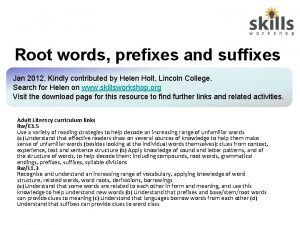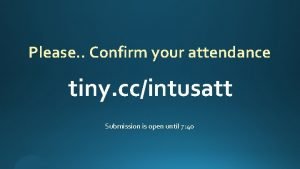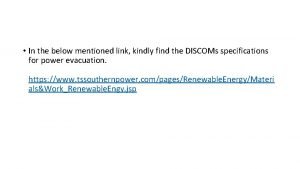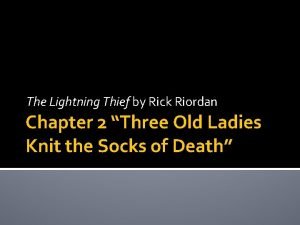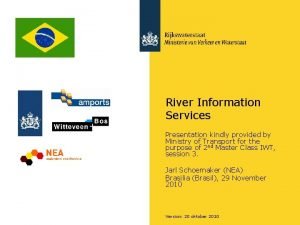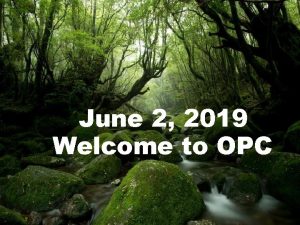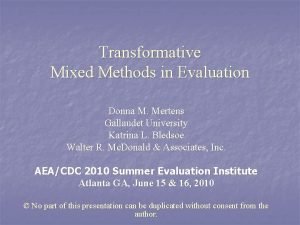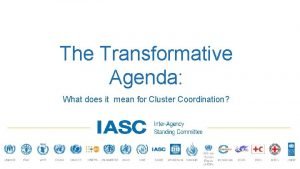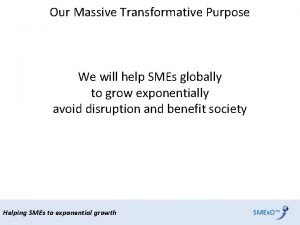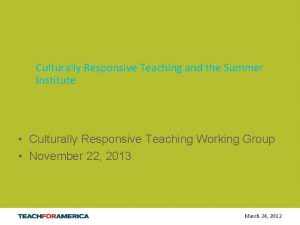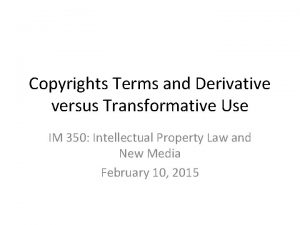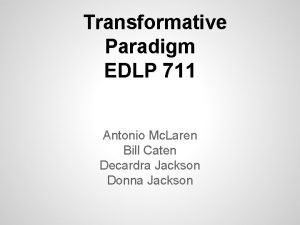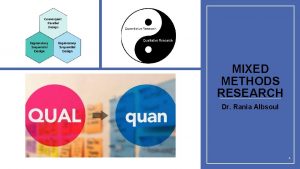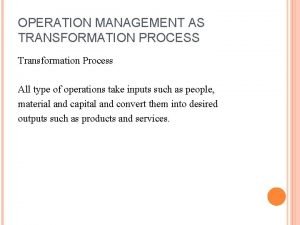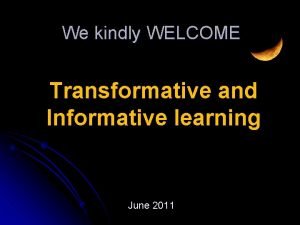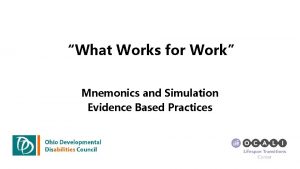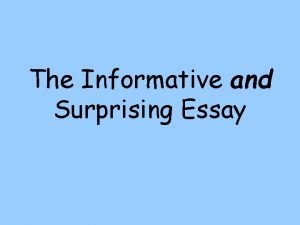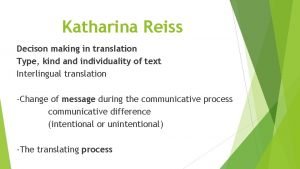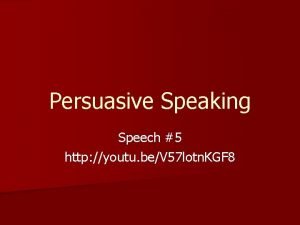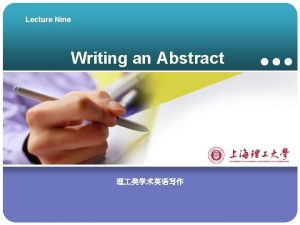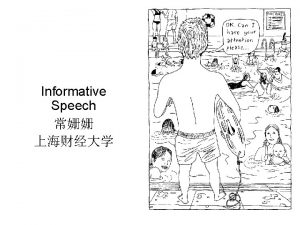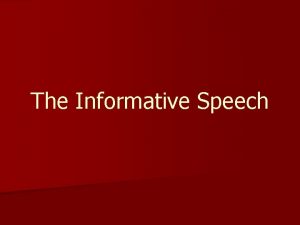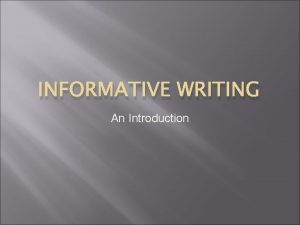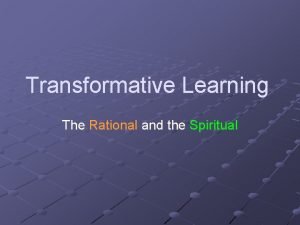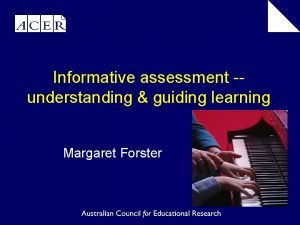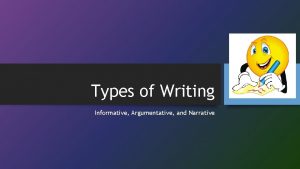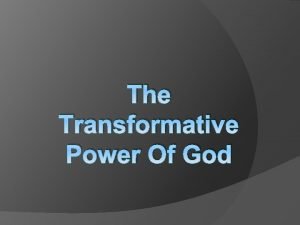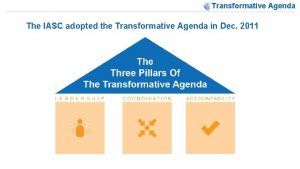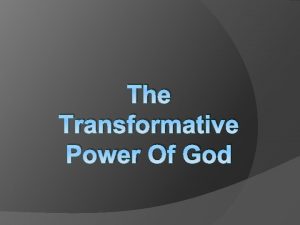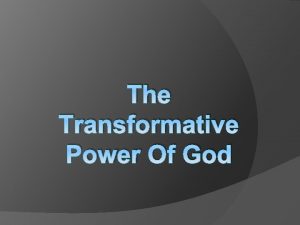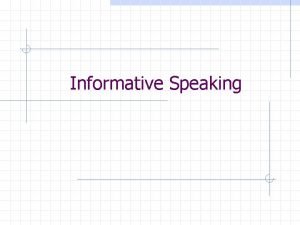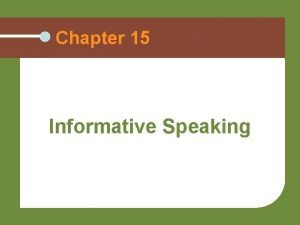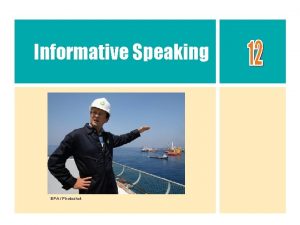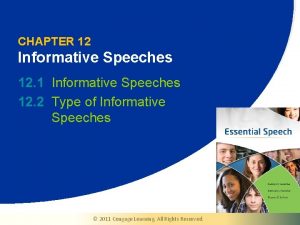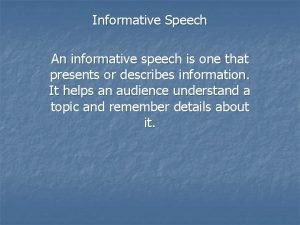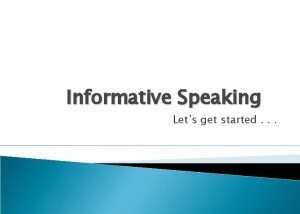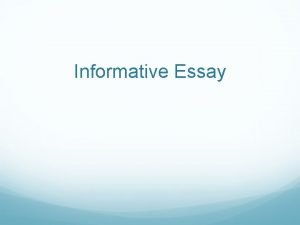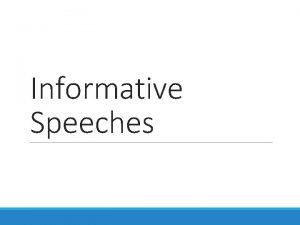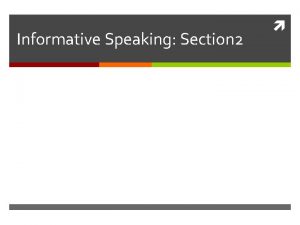We kindly WELCOME Transformative and Informative learning June








































- Slides: 40

We kindly WELCOME Transformative and Informative learning June 2011

Transformative and Informative learning There are two different strategies of learning and adaptation (Piaget), when we are receiving new knowledge, (Piaget), experience, trainings, teachings, insights etc: We Assimilate new in our close system of value, “box”, paradigm etc without changing our own self * … We Accommodate new in our open system of value, paradigm by voluntary changing our own self *… *… according to new information, situation, experiences, insights etc

Informative learning or Assimilation, or Additive learning systems, are increase what we already know, adds to our skills, extends already established capacities by bringing new knowledge to an existing worldview, frames, “box”, reference, paradigm etc without changing our own self according to new information, situation, experiences, insights etc

Informative learning or Assimilation Informative learning conceptions (Saljo 1979) 1. Learning as a quantitative increase in knowledge. 2. Learning is acquiring information or “knowing a lot” 3. Learning as memorizing. Learning is storing information that can be reproduced. 4. Learning as acquiring facts, skills and methods that can be retained and used as necessary. 5. Learning as making sense or abstracting meaning. Learning involves relating parts of the subject matter to each other and to the real world. 6. Learning as interpreting and understanding reality in a different way. Learning involves comprehending the world by re-interpreting knowledge.

Transformative learning or Accommodation “Transformative learning involves experiencing a deep, structural shift in the basic premises of thought, feelings, and actions. It is a shift of consciousness that dramatically and irreversibly alters our way of being in the world. Such a shift involves our understanding of ourselves and our self-locations; our relationships with other humans and with the natural world; our understanding of relations of power in interlocking structures of class, race and gender; our body awarenesses, our visions of alternative approaches to living; and our sense of possibilities for social justice and peace and personal joy. " O’Sullivan (2003)

+ and – of two learning system Informative learning: + there are no any limitations on participants numbers + not ask from speaker so much psychological and therapeutically skills, specific personal character etc Transformative learning: - there are strict limitations on Listeners numbers - ask from speaker so much psychological and therapeutically skills, specific personal character etc - such kind of learning + such kind of learning generally do no help generally can help a lot to learners change our own self

Resistance Factors in learning Informative learning: Transformative learning: Authoritarian way of teaching, Broader minded way of more pressure, less teaching, less pressure, more engorgement, support, practical engorgement, support, training. Learners generally feel practical training, s practical training, pace to a lot of pressure on him/her by change, trainer by skilful means own old, past experiences, helping Learner to grow in our lacking a space to grow own realisations, insights and find our own path in depths of heart Learner

Graphic of Learning processes Informative learning – generally during course of time, particular after crisis our Competence go down Transformative learning - generally during course of time, particular after crisis our Competence go up, grow and increase Competence Time

Crisis – time and space for our paradigm shift Intervention “window” Pre-Crisis Precipitating event Enhanced, grow capacity to cope Slightly diminished capacity to cope “Angle of Recovery” Seriously diminished capacity to cope

Sequence of paradigm shift process 4 th Re-orientation Informative learning 1 st De-stabilisation 2 nd Disorientation Confidence & Morale Time Transformative learning 3 rd Facilitating Environment

1 st De-stabilisation for paradigm shift l Unpredictable process l Effected by casual remarks as much as deliberate intervention l Has two necessary elements l Declaration l Application

2 nd Disorientation for paradigm shift l l Has cognitive and affective components May include l l l Depression Frustration Anger Guilt “Attempted apathy” (not denial)

3 rd Facilitating Environment th 4 Re-orientation for paradigm shift Resembles additive learning l New learning still fragile l Diminishing echoes of whole sequence l Facilitating environment still required in initial stages l

Trainer Characteristics for Transformative l. Instructor Characteristics and Roles Which Facilitate Transformational Learning l Encourage students to reflect on and share their feelings and thoughts in class. l Be holistically oriented, aware of body, mind, and spirit in the learning process. l Become transcendent of his own beliefs and accepting of others' beliefs. l Cultivate awareness of alternate ways of learning. l Establish an environment characterized by trust and care. l Facilitate sensitive relationships among the participants. l Demonstrate ability to serve as an experienced mentor reflecting on his own journey. l Help students question reality in ways that promote shifts in their worldview.

Student Characteristics for Transformative l. Student Characteristics and Roles which Facilitate Transformational Learning l Students must be free to determine their own reality, as opposed to social realities defined by others or by cultural institutions. l Students must be ready for and open to change. l Those with a wider variety of life experiences, including prior stressful life events, are likely to experience more transformation. l Cultivate the ability to transcend past contexts of learning and experience. l Students must be willing and able to integrate critical reflection into their school work and personal life. l Students must be able to access both rational and affective mental functioning. l Have sufficient maturity to deal with paradigm shifts and material which differs from their current beliefs.

Course Content for Transformative l. – part 1 Course Content and Instructional Activities and Environmentsto Facilitate Transformational Learning l Critical reflection, l Rational discourse, l Constructivist approach to course design and instructional objectives, l Inquiries into the origins and destinies of individual existence, l Mind exploration (dreams, out-of-body, near death experience, meditation, altered states of consciousness, hypnosis), l The mysteries of human suffering and purpose, l Paradigms of consciousness and healing from other cultures (Chinese medicine, shamanism, Yoga, etc. ), l Guided imagery,

Course Content for Transformative l. – part 2 Course Content and Instructional Activities and Environmentsto Facilitate Transformational Learning l Sensory awareness development (Feldenkrais, hypnosis, etc. ), l Dance and movement, l Breath work, l Touch (giving and receiving), l Atmosphere of openness, safety, and emotional support, l Instructors and students have full information and are free from coercion, l All students have equal opportunity to assume various roles, l Students can become critically reflective of assumptions, l Instructors and students are empathetic and good listeners, and are willing to search for common ground or a synthesis of different points of view.

Professional Challenges for Transformative l. – part 1 Professional Challenges and Ethical Considerations for Instructors Facilitating Transformational Learning l Transference and counter-transference among students and instructor, l Confidentiality, l Sexual attraction, l Cognitive dissonance, l Repressed memories emerging into consciousness creating stress, l Burnout and intensity beyond the student's ability to cope, l Appropriate supervision with minimal interference in the process, l Conflict between students,

Professional Challenges for Transformative l. – part 2 l l l Code of ethics for the classroom environment, Inappropriate touch, Precipitating transformational learning in a learner who is not prepared or does not fully understand its possible consequences, Providing adequate transformational learning to students who are eager and receptive to personal change and evolution, Is an instructor qualified to decide which, among a learner's beliefs, should be exposed to transformation, There can be a fine line between education and therapeutic intervention; should a teacher function as therapist to his students?

For more details Please check web l Successful Balanced and Healthy lifestyle program http: //bhls. wordpress. com l Bhaktivedanta Hospital (www. Bhaktivedanta. Hospital. com) Presentation are formatted by BVG Janaka das

We kindly WELCOME Transformative and Informative learning June 2011

Transformative and Informative learning There are two different strategies of learning and adaptation (Piaget), when we are receiving new knowledge, (Piaget), experience, trainings, teachings, insights etc: We Assimilate new in our close system of value, “box”, paradigm etc without changing our own self * … We Accommodate new in our open system of value, paradigm by voluntary changing our own self *… *… according to new information, situation, experiences, insights etc

Informative learning or Assimilation, or Additive learning systems, are increase what we already know, adds to our skills, extends already established capacities by bringing new knowledge to an existing worldview, frames, “box”, reference, paradigm etc without changing our own self according to new information, situation, experiences, insights etc

Informative learning or Assimilation Informative learning conceptions (Saljo 1979) 1. Learning as a quantitative increase in knowledge. 2. Learning is acquiring information or “knowing a lot” 3. Learning as memorizing. Learning is storing information that can be reproduced. 4. Learning as acquiring facts, skills and methods that can be retained and used as necessary. 5. Learning as making sense or abstracting meaning. Learning involves relating parts of the subject matter to each other and to the real world. 6. Learning as interpreting and understanding reality in a different way. Learning involves comprehending the world by re-interpreting knowledge.

Transformative learning or Accommodation “Transformative learning involves experiencing a deep, structural shift in the basic premises of thought, feelings, and actions. It is a shift of consciousness that dramatically and irreversibly alters our way of being in the world. Such a shift involves our understanding of ourselves and our self-locations; our relationships with other humans and with the natural world; our understanding of relations of power in interlocking structures of class, race and gender; our body awarenesses, our visions of alternative approaches to living; and our sense of possibilities for social justice and peace and personal joy. " O’Sullivan (2003)

+ and – of two learning system Informative learning: + there are no any limitations on participants numbers + not ask from speaker so much psychological and therapeutically skills, specific personal character etc Transformative learning: - there are strict limitations on Listeners numbers - ask from speaker so much psychological and therapeutically skills, specific personal character etc - such kind of learning + such kind of learning generally do no help generally can help a lot to learners change our own self

Graphic of Learning processes Informative learning – generally during course of time, particular after crisis our Competence go down Transformative learning - generally during course of time, particular after crisis our Competence go up, grow and increase Competence Time

Resistance Factors in learning Informative learning: Transformative learning: Authoritarian way of teaching, Broader minded way of more pressure, less teaching, less pressure, more engorgement, support, practical engorgement, support, training. Learners generally feel practical training, s practical training, pace to a lot of pressure on him/her by change, trainer by skilful means own old, past experiences, helping Learner to grow in our lacking a space to grow own realisations, insights and find our own path in depths of heart Learner

Crisis – time and space for our paradigm shift Intervention “window” Pre-Crisis Precipitating event Enhanced, grow capacity to cope Slightly diminished capacity to cope “Angle of Recovery” Seriously diminished capacity to cope

Sequence of paradigm shift process 4 th Re-orientation Informative learning 1 st De-stabilisation 2 nd Disorientation Confidence & Morale Time Transformative learning 3 rd Facilitating Environment

1 st De-stabilisation for paradigm shift l Unpredictable process l Effected by casual remarks as much as deliberate intervention l Has two necessary elements l Declaration l Application

2 nd Disorientation for paradigm shift l l Has cognitive and affective components May include l l l Depression Frustration Anger Guilt “Attempted apathy” (not denial)

3 rd Facilitating Environment th 4 Re-orientation for paradigm shift Resembles additive learning l New learning still fragile l Diminishing echoes of whole sequence l Facilitating environment still required in initial stages l

Trainer Characteristics for Transformative l. Instructor Characteristics and Roles Which Facilitate Transformational Learning l Encourage students to reflect on and share their feelings and thoughts in class. l Be holistically oriented, aware of body, mind, and spirit in the learning process. l Become transcendent of his own beliefs and accepting of others' beliefs. l Cultivate awareness of alternate ways of learning. l Establish an environment characterized by trust and care. l Facilitate sensitive relationships among the participants. l Demonstrate ability to serve as an experienced mentor reflecting on his own journey. l Help students question reality in ways that promote shifts in their worldview.

Student Characteristics for Transformative l. Student Characteristics and Roles which Facilitate Transformational Learning l Students must be free to determine their own reality, as opposed to social realities defined by others or by cultural institutions. l Students must be ready for and open to change. l Those with a wider variety of life experiences, including prior stressful life events, are likely to experience more transformation. l Cultivate the ability to transcend past contexts of learning and experience. l Students must be willing and able to integrate critical reflection into their school work and personal life. l Students must be able to access both rational and affective mental functioning. l Have sufficient maturity to deal with paradigm shifts and material which differs from their current beliefs.

Course Content for Transformative l. – part 1 Course Content and Instructional Activities and Environmentsto Facilitate Transformational Learning l Critical reflection, l Rational discourse, l Constructivist approach to course design and instructional objectives, l Inquiries into the origins and destinies of individual existence, l Mind exploration (dreams, out-of-body, near death experience, meditation, altered states of consciousness, hypnosis), l The mysteries of human suffering and purpose, l Paradigms of consciousness and healing from other cultures (Chinese medicine, shamanism, Yoga, etc. ), l Guided imagery,

Course Content for Transformative l. – part 2 Course Content and Instructional Activities and Environmentsto Facilitate Transformational Learning l Sensory awareness development (Feldenkrais, hypnosis, etc. ), l Dance and movement, l Breath work, l Touch (giving and receiving), l Atmosphere of openness, safety, and emotional support, l Instructors and students have full information and are free from coercion, l All students have equal opportunity to assume various roles, l Students can become critically reflective of assumptions, l Instructors and students are empathetic and good listeners, and are willing to search for common ground or a synthesis of different points of view.

Professional Challenges for Transformative l. – part 1 Professional Challenges and Ethical Considerations for Instructors Facilitating Transformational Learning l Transference and counter-transference among students and instructor, l Confidentiality, l Sexual attraction, l Cognitive dissonance, l Repressed memories emerging into consciousness creating stress, l Burnout and intensity beyond the student's ability to cope, l Appropriate supervision with minimal interference in the process, l Conflict between students,

Professional Challenges for Transformative l. – part 2 l l l Code of ethics for the classroom environment, Inappropriate touch, Precipitating transformational learning in a learner who is not prepared or does not fully understand its possible consequences, Providing adequate transformational learning to students who are eager and receptive to personal change and evolution, Is an instructor qualified to decide which, among a learner's beliefs, should be exposed to transformation, There can be a fine line between education and therapeutic intervention; should a teacher function as therapist to his students?

For more details Please check web l Successful Balanced and Healthy lifestyle program http: //bhls. wordpress. com l Bhaktivedanta Hospital (www. Bhaktivedanta. Hospital. com) Presentation are formatted by BVG Janaka das
 Kindly welcome
Kindly welcome Suffix of happy
Suffix of happy Kindly recite surah fatiha
Kindly recite surah fatiha Currant jelly stool
Currant jelly stool Please find the link below
Please find the link below Chapter 2 of the lightning thief
Chapter 2 of the lightning thief Kindly provided
Kindly provided Welcome june blessings
Welcome june blessings Good morning welcome june
Good morning welcome june Mertens transformative paradigm
Mertens transformative paradigm Transformative agenda meaning
Transformative agenda meaning Massive transformative purpose
Massive transformative purpose Transformative resistance
Transformative resistance Copyright transformative vs. derivative
Copyright transformative vs. derivative Institute for transformative technologies
Institute for transformative technologies Transformative paradigm definition
Transformative paradigm definition What is the transformation process
What is the transformation process Albsoul
Albsoul Transactional leadership vs transformational leadership
Transactional leadership vs transformational leadership What is the transformation process in operations management
What is the transformation process in operations management Gender-transformative
Gender-transformative Informative learning
Informative learning Cuadro comparativo e-learning y b-learning
Cuadro comparativo e-learning y b-learning Wise men three clever are we
Wise men three clever are we 30 days has september
30 days has september January february march april june july
January february march april june july Informative expressive operative
Informative expressive operative Informative and surprising essay
Informative and surprising essay Katharina reiss
Katharina reiss Informative and persuasive venn diagram
Informative and persuasive venn diagram Animals and human language chapter 2
Animals and human language chapter 2 Communicative and informative signals
Communicative and informative signals Communicative and informative signals
Communicative and informative signals Persuasive informative speech
Persuasive informative speech Contents of an abstract
Contents of an abstract Inductive and analytical learning in machine learning
Inductive and analytical learning in machine learning Inductive and analytical learning
Inductive and analytical learning Lazy learning vs eager learning
Lazy learning vs eager learning Tony wagner's seven survival skills
Tony wagner's seven survival skills Flax exam
Flax exam June 2007 physics regents answers
June 2007 physics regents answers

